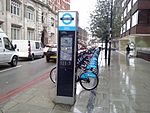Jack the Ripper Museum
2015 establishments in EnglandJack the RipperMuseums established in 2015Tourist attractions in the London Borough of Tower HamletsUse British English from May 2016

The Jack the Ripper Museum is a museum and tourist attraction that opened in August 2015 in Cable Street, London. It recreates the East end of London setting in which the unsolved Jack the Ripper murders took place in 1888, and exhibits some original artefacts from the period as well as waxwork recreations of crime scenes and sets. The museum was founded by Mark Palmer-Edgecumbe, a former head of diversity for Google.The project's planning application described it as a "Museum of Women's History". Its change of focus to Jack the Ripper was only revealed when the facade of the building became visible a year later, leading to numerous protests.
Excerpt from the Wikipedia article Jack the Ripper Museum (License: CC BY-SA 3.0, Authors, Images).Jack the Ripper Museum
Cable Street, London Wapping
Geographical coordinates (GPS) Address Nearby Places Show on map
Geographical coordinates (GPS)
| Latitude | Longitude |
|---|---|
| N 51.510805 ° | E -0.067972 ° |
Address
Moko Sellars
Cable Street 10
E1 8JG London, Wapping
England, United Kingdom
Open on Google Maps










